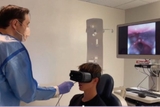
By Matthew J. Ryan, MD
Unsedated transnasal endoscopy (uTNE) allows patients aged 7 and older to undergo evaluation of the upper GI tract without the need for general anesthesia. This is especially valuable for patients with eosinophilic esophagitis (EoE), who often require repeat procedures to monitor their disease. There is a large percentage of pediatric patients with complaints involving swallowing, throat clearing, globus sensation, chronic cough or heartburn who would also benefit from uTNE.
At Children’s Hospital of Philadelphia (CHOP), we have performed uTNE on select patients since 2019. The procedure is performed with an ultra-thin endoscope inserted through the nose and down the esophagus. Pediatric patients tolerate this procedure with minimal intervention, using 2% lidocaine gel to numb the nasopharynx, and visual distraction with VR goggles or a video screen.
While we have always used a 3.1 mm pediatric bronchoscope, until recently there were several limitations to uTNE including: A 1.2 mm biopsy channel A single lumen for air or water A length of 60 cm
In 2022, a single-use sterile gastroscope became available, providing a 2 mm biopsy channel and 110 cm of length — allowing us to see further into the upper GI tract and capture larger samples for biopsies. CHOP was the first to use this new device — the EvoEndo® single-use gastroscope — in pediatric patients.
Today, both distal and proximal biopsies (4-8) can be obtained during uTNE to support a patient’s diagnosis and/or disease monitoring. Pre-procedure prep for esophageal biopsies requires 2 hours NPO, while gastric and duodenal biopsies require 4 hours NPO.
The procedure takes less than 10 minutes and there is no recovery time. The procedure has been well tolerated and well received by more than 98% of patients. Many patients have returned for repeat procedures.
Since 2019, we have performed more than 250 uTNE procedures at CHOP with only four aborted cases. (Two 7-year-olds stopped because of anxiety, one fainted and one vomited.)
The benefits of the new single-use gastroscope include:
- Risk of contamination is eliminated
- Larger biopsies mean fewer passes and larger samples
- Ability to obtain gastric and duodenal biopsies, if needed
We see greater use for uTNE in the future, specifically in outpatient clinics, for the following reasons:
- A single-use gastroscope is more portable than a re-useable scope
- Eliminates the need for an anesthesiologist
- Faster turn-around time for diagnosis and treatment plan
- Minimal clean up or processing
- Potential to use for interventional procedures such as nasojejunal (NJ) tube placement
Matthew J. Ryan, MD, is a pediatric gastroenterologist at Children’s Hospital of Philadelphia who specializes in aerodigestive disorders and unsedated endoscopy.
Featured in this article
Specialties & Programs
By Matthew J. Ryan, MD
Unsedated transnasal endoscopy (uTNE) allows patients aged 7 and older to undergo evaluation of the upper GI tract without the need for general anesthesia. This is especially valuable for patients with eosinophilic esophagitis (EoE), who often require repeat procedures to monitor their disease. There is a large percentage of pediatric patients with complaints involving swallowing, throat clearing, globus sensation, chronic cough or heartburn who would also benefit from uTNE.
At Children’s Hospital of Philadelphia (CHOP), we have performed uTNE on select patients since 2019. The procedure is performed with an ultra-thin endoscope inserted through the nose and down the esophagus. Pediatric patients tolerate this procedure with minimal intervention, using 2% lidocaine gel to numb the nasopharynx, and visual distraction with VR goggles or a video screen.
While we have always used a 3.1 mm pediatric bronchoscope, until recently there were several limitations to uTNE including: A 1.2 mm biopsy channel A single lumen for air or water A length of 60 cm
In 2022, a single-use sterile gastroscope became available, providing a 2 mm biopsy channel and 110 cm of length — allowing us to see further into the upper GI tract and capture larger samples for biopsies. CHOP was the first to use this new device — the EvoEndo® single-use gastroscope — in pediatric patients.
Today, both distal and proximal biopsies (4-8) can be obtained during uTNE to support a patient’s diagnosis and/or disease monitoring. Pre-procedure prep for esophageal biopsies requires 2 hours NPO, while gastric and duodenal biopsies require 4 hours NPO.
The procedure takes less than 10 minutes and there is no recovery time. The procedure has been well tolerated and well received by more than 98% of patients. Many patients have returned for repeat procedures.
Since 2019, we have performed more than 250 uTNE procedures at CHOP with only four aborted cases. (Two 7-year-olds stopped because of anxiety, one fainted and one vomited.)
The benefits of the new single-use gastroscope include:
- Risk of contamination is eliminated
- Larger biopsies mean fewer passes and larger samples
- Ability to obtain gastric and duodenal biopsies, if needed
We see greater use for uTNE in the future, specifically in outpatient clinics, for the following reasons:
- A single-use gastroscope is more portable than a re-useable scope
- Eliminates the need for an anesthesiologist
- Faster turn-around time for diagnosis and treatment plan
- Minimal clean up or processing
- Potential to use for interventional procedures such as nasojejunal (NJ) tube placement
Matthew J. Ryan, MD, is a pediatric gastroenterologist at Children’s Hospital of Philadelphia who specializes in aerodigestive disorders and unsedated endoscopy.
Contact us
Division of Gastroenterology, Hepatology and Nutrition